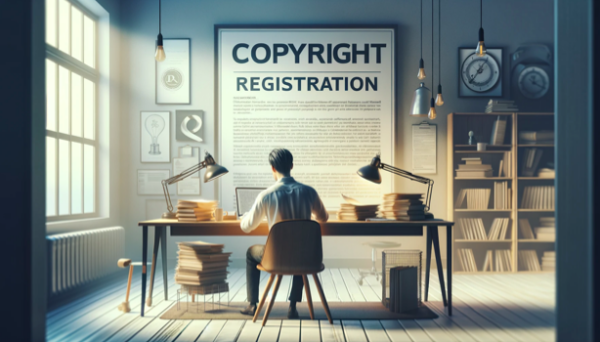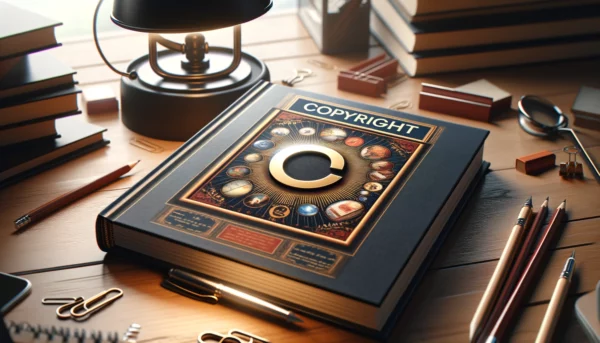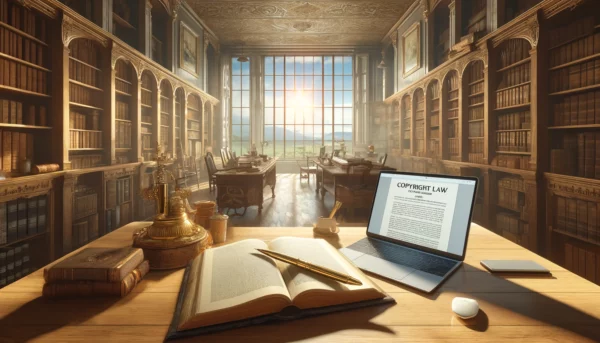In the intricate world of publishing, comprehending copyrights and licenses is not just a legal necessity but a cornerstone for success and ethical practice. Copyrights serve as the bedrock of intellectual property rights, safeguarding creators by granting them exclusive control over their creations. On the other hand, licenses are the instruments through which these rights are shared, transferred, or limited, allowing for the legal dissemination and use of copyrighted material.
This article delves into the essential concepts of copyrights and licenses in the publishing realm, aiming to demystify the complexities surrounding the legal rights of creators and users alike in writing. Understanding these key concepts is not only crucial for legal compliance but also for fostering innovation and respecting the creative contributions of individuals in the dynamic landscape of self-publishing and writing.

Understanding Copyrights and Licenses
Copyright is a legal construct designed to protect the intellectual property of creators, ensuring they retain exclusive control over their original works. It applies to a diverse array of creations, from literary compositions and musical scores to technological innovations and artistic expressions. The fundamental principle underpinning copyright is the provision of exclusive rights to the creator. These rights typically include the ability to reproduce, distribute, perform, display, and create derivative works based on the original. Essentially, copyright grants the creator a legal monopoly over the use of their work for a specified time period, usually the creator’s lifetime plus several years post-mortem, varying by jurisdiction.
Copyright law fosters creativity and innovation by ensuring creators’ protection and potential rewards. It establishes guidelines for the use of copyrighted works, including fair use and managing derivatives. The law also outlines the process and requirements for obtaining copyrights and licenses, ensuring creators are recognized and compensated for their contributions to culture and knowledge.
Types of Copyright and Licenses
Copyrights and licenses come in various forms, each with its own set of permissions and restrictions. The two primary categories are exclusive and non-exclusive licenses.
Exclusive Licenses
An exclusive license grants a single party the right to use the copyrighted work in a specific way or in a particular market, effectively barring the copyright owner and any other parties from exploiting these rights. For example, a publisher might be granted an exclusive license to print and sell a novel in North America.
Non-Exclusive Licenses
In contrast, a non-exclusive license allows the copyright owner to grant the same rights or similar rights to multiple parties. This means the creator can license their work to several entities, perhaps in different formats or regions, without limiting their rights to use and distribute the work.
Understanding ISBNs in Publishing
An International Standard Book Number (ISBN) is a unique identifier for books, intended to standardize and simplify their classification and sale. Every ISBN is associated with essential information about a book, such as its title, author, and publisher, facilitating its tracking in publishing systems worldwide. Acquiring an ISBN is a critical step for authors and publishers, as it enables a book’s distribution and sale across various retail and digital platforms.
Start Your Publishing Journey FOR FREECreative Commons licenses
This represents a modern, flexible approach to copyright licensing, designed for the digital age. Creative Commons licenses are typically non-exclusive licenses because multiple individuals or entities can use the same work under the terms specified in the Creative Commons license. These licenses allow the copyright holder to grant certain permissions to others while retaining their rights. This means that the copyright holder can offer the same work to multiple users or licensees simultaneously, and those users can also benefit from the permissions granted by the license.
In self-publishing, copyright automatically protects the author’s work upon creation, granting exclusive rights over reproduction and distribution. Authors can enhance protection through formal copyright registration, providing a robust defense against unauthorized use. Understanding and leveraging these rights is essential for maximizing control and revenue from self-published works.
The Role of the Copyright Owner
The copyright owner, the creator of the work, holds a unique position with both significant rights and responsibilities. Primarily, they possess the exclusive right to reproduce, distribute, perform, display, and create derivative works based on the original content. These rights empower them to control how their work is used and to seek financial benefit from it. The owner also has the responsibility to enforce these rights, which involves monitoring usage and taking legal action against unauthorized use or infringement.
A key aspect of the copyright owner’s role is the ability to transfer or assign their rights to others. This can be done in whole or in part and can be temporary or permanent. For example, an author may transfer the rights to publish their book to a publishing company while retaining the rights to adapt the book into a screenplay. Such transfers are typically executed through licensing agreements, which outline the terms and conditions of the transfer.
Furthermore, copyright law recognizes the concept of moral rights, which are personal to the creator and often non-transferable. Moral rights include the right to be credited as the author of the work and to object to any derogatory treatment of the work that could harm the creator’s reputation. Usage rights, on the other hand, pertain to how the work can be used by those who have been granted a license. These might include the right to make copies, distribute, perform, or create adaptations of the work.
The Process of Obtaining a License
Obtaining a copyright license involves a series of deliberate steps to ensure legal compliance and mutual agreement between the copyright owner and the licensee. These steps can be broken down into two main steps.
STEP 1: The process typically begins with the licensee identifying a copyrighted work they wish to use and approaching the owner to negotiate terms. This initial stage involves discussions about the scope of the license, including what rights will be granted, for what duration, and in what territories.
STEP 2: Once the terms are preliminarily agreed upon, the parties draft a copyright license agreement. This legal document is the cornerstone of the licensing process, detailing the rights being licensed, any limitations or conditions, the duration of the license, financial arrangements such as royalties or lump sum payments, and provisions for termination or renewal of the agreement. It may also specify how the work can be used, any credit requirements, and how potential disputes will be resolved.
Contractual agreements provide a framework for the relationship between the copyright owner and the licensee, ensuring clarity and legal protection for both sides. The agreement not only outlines the permissions granted but also the repercussions of violating those terms. It is vital for both parties to thoroughly understand and agree to the terms of the contract before it is signed, as it governs the legal rights and obligations regarding the use of copyrighted material.
AI and Copywriting
The emergence of Artificial Intelligence (AI) has greatly simplified the process of acquiring copyrights and licenses, introducing efficiency and automation into various aspects of copyright licensing while also significantly reducing costs.
For example, at Spines, a pioneering AI-publishing platform, we offer a free copyright tool that is typically priced between $50 and $120. Spines’ commitment to supporting the creative community is evident in its efforts to simplify intellectual property protection and navigate the complexities of copyright law. Register for free with Spines and upload your manuscript to obtain a free copyright license agreement.
Common Issues in Copyrights and Licenses
Copyright infringement is a significant issue in licensing, generally occurring when someone uses copyrighted material without permission, violating the owner’s exclusive rights. This includes unauthorized reproduction of books, distribution of pirated music, or commercial use of photographs without consent, leading to legal disputes, penalties, and damage to reputations.
Fair use, vital in publishing, allows limited use of copyrighted content for purposes like commentary, criticism, or education without permission. Determining fair use involves factors like purpose, nature of the work, amount used, and impact on the original’s market value. Its complex, subjective application often leads to legal uncertainties.
Derivative works, based on existing copyrighted content, require permission from the owner. Unauthorized derivatives may lead to infringement claims, with ambiguity in defining what’s legitimate creative expression versus exploitation of another person or intellectual property.
Special Considerations in Different Domains
Copyright considerations can vary significantly across different forms of media. In literary works, the focus is often on textual content, including books, articles, and manuscripts, where reproduction and distribution rights are paramount. Fine art, encompassing paintings, sculptures, and installations, requires careful navigation of reproduction rights. Sound recordings involve not only the composition’s copyright but also the rights related to the recording itself, necessitating agreements with both composers and performers.
Public domain and public performance rights are crucial concepts. Works in the public domain are free from copyright restrictions, allowing unrestricted use. However, determining the public domain status can be complex, depending on the jurisdiction and the original date of publication. Public performance rights, relevant to plays, concerts, and broadcasts, require specific attention to how and where copyrighted works are performed publicly, often requiring separate licensing agreements. These considerations underscore the need for tailored approaches in different domains and regions to ensure compliance and respect for copyright laws.
Navigating the complexities of copyrights and licenses in publishing is not just a legal imperative but a fundamental aspect of respecting and upholding intellectual property rights. This understanding is crucial for creators, publishers, and users alike to ensure ethical and lawful use of creative works. While this article provides a foundational overview, the intricacies of individual situations often necessitate professional legal advice. Such guidance ensures tailored solutions and compliance with evolving laws and regulations. Ultimately, responsible navigation of these legal landscapes fosters a respectful and thriving environment for creativity and innovation in the diverse world of publishing.
Start Your Publishing Journey FOR FREE






